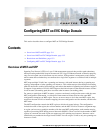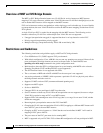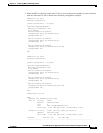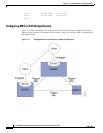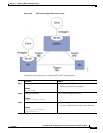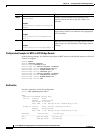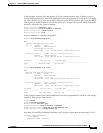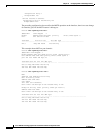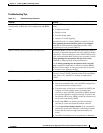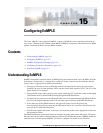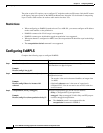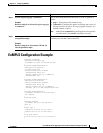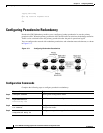
13-9
Cisco ASR 901 Series Aggregation Services Router Software Configuration Guide
OL-23826-09
Chapter 13 Configuring MST on EVC Bridge Domain
Contents
Troubleshooting Tips
Table 13-1 Troubleshooting Scenarios
Problem Solution
Multiple Spanning Tree Protocol (MSTP) incorrectly or
inconsistently formed due to misconfiguration and BPDU
loss
To avoid BPDU loss, re-configure these on the following
nodes:
• Configuration name
• Bridge revision
• Provider-bridge mode
• Instance to VLAN mapping
Determine if node A is sending BPDUs to node B. Use the
show spanning-tree mst interface gi1/1 service instance
command for each interface connecting the nodes. Only
designated ports relay periodic BPDUs.
MSTP correctly formed, but traffic flooding occurs Intermittent BPDU loss occurs when the spanning tree appears
incorrectly in the show commands, but relays topology change
notifications. These notifications cause a MAC flush, forcing
traffic to flood until the MAC addresses are re-learned. Use the
debug spanning-tree mst packet full {received | sent}
command to debug topology change notifications.
Use the debug spanning-tree mst packet brief {received |
sent} command on both nodes to check for missing BPDUs.
Monitor the timestamps. A time gap greater than or equal to
six seconds causes topology change.
MSTP shows incorrect port state When the spanning tree protocol (STP) attempts to change the
port state, it uses L2VPN. Check the value of the sent update.
If the value is Yes, then STP is awaiting an update from
L2VPN.
Packet forwarding does not match the MSTP state Complete the following steps to verify and troubleshoot:
1. Shut down redundant links, remove MSTP configuration,
and ensure that basic bridging works.
2. Check the state of each port as calculated by MSTP, and
compare it with the packet counts transmitted and
received on ports and EFPs controlled by MSTP. Normal
data packets should be sent/received only on ports in the
forwarding (FWD) state. BPDUs should be sent/received
on all ports controlled by MSTP.
3. Ensure that BPDUs are flowing and that root bridge
selection is correct and check the related scenarios.
4. Use the show l2vpn bridge-domain detail command to
confirm the status of the members of the bridge domain.
Ensure that the relevant bridge domain members are
active.
5. Check the forwarding state as programmed in hardware.



